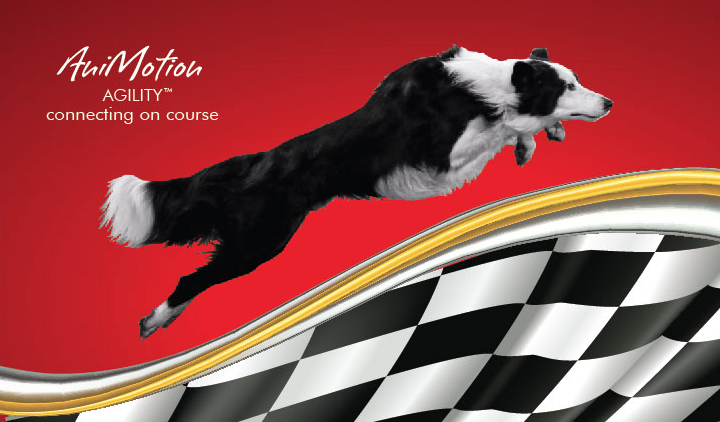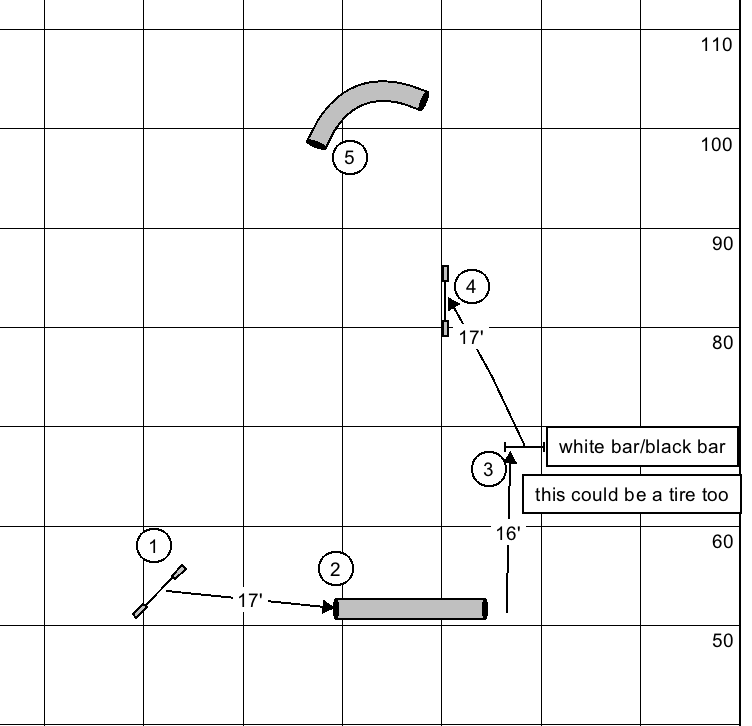Colour & Jumping
PART II: a study in Bar Colour
by Nicki Gurr BSc, BEd, Masters Judge AAC/UKI
The second half of this Vision Study compares striding to jumps with Black Bars vs white bars. The test subjects were dogs that typically take off Early, or add strides, when approaching straight on (perpendicular) jumps. Three sequences that emphasized these approaches were sent to participants. They were set up on grass/sand surfaces. Bar Colour recommended for these surfaces was black (grass and sand take on yellow tones on a dichromatic spectrum and Black is a bold contrast). Bars were taped solidly, without contrasting strips, to make them as prominent as possible.
The Set Ups:
TEST ONE: 90 degree approach to a jump out of a tunnel. Distances 15'- 18'. Bar colour: White and Black.
RESULTS: Black bars produced fewer strides overall than white bars. The unintended 'environmental noise' was a significant finding in the importance of minimizing equipment, etc on perimeters of a ring. As shown in the test dog, without background objects competing for the dog's focus, both jumping efforts at 15'/16' with Black OR White bars, was relaxed and appropriate. Added strides were eliminated.
TEST TWO: A Circular sequence with straight on (perpendicular) approaches to a Tire and jump. Three dogs ran this setup: Two on grass, one on silica sand. All dogs used black bars. One dog was able to compare performance on an Orange tire with narrow black markings to be 'tiger striped', and a black tire (by wrapping black fabric around it).
RESULTS: Orange vs Black Tire: The black self-healing tire was never 'broken'. It was performed approx. 6 times. The Orange tire was 'broken' in the majority of attempts (only the first attempt is shown). The 'white' bars used had blue striping on them so had more visible contrast than solid white bars. That said, The Black Bars produced fewer strides. All three dogs had more balanced striding and fewer strides with the black bars on this setup.
TEST THREE: Soft slice approaching and exiting a tunnel.
RESULTS: More data needed (of course!) but this dog had less strides on black bars than white bars.
TEST FOUR: Set up Distance from a Jump. White bars were run first. Black Bars produced fewer strides on the bigger distances and also better 'intent' / balance approaching the bar.
CONCLUSION: Yes the test group was small, but the trend in all dogs showed fewer strides taken and better balance in striding to a black bar. When white bars were run first, black bars improved the performance when run second. When black bars were run first, the white bar pattern was similar/closer to the black - suggesting possible patterning to white after running black but not vice versa. In slow motion the intent of the strides appears different as well. The dogs are sometimes more forward/driving towards the jump vs pulling back and 'guessing' about the take off. Dogs without Early take off /adding strides ran the loop setup and performed confidently as well. The Black bars produced confident jumping in all of the dogs, and in the dogs that had ETOs the black bars produced better performances.
Sighting bars at speed should be as easy as possible, given how quickly the dogs are navigating a course and making choices. If bar colour can make that choice easier for them and SAFER for them, then it needs to be considered seriously in choosing tape colours for jump bars AND tires. The 'straight on' (perpendicular) approaches are the most difficult if colours or lighting conditions are compromised. Slices are easier for the dogs to assess take off spots. Using dark bars on straight on approaches is where dark bars should be used first, if there are not enough available to use on every jump. Bar colour, surface colour, lighting/shadows will all play a role in how a dog can sight a jump bar. Here is an example of too little information on the jump bars relative to the depth of the double jump for this dog:
In this photo, the dog clearly thought there was only one bar. The bars are orange with three small black bands. This is backwards for these conditions. There are continuous lines of shadow on the ground. Broken pieces of black banding in sunny conditions with shadows are misleading, and difficult to analyze at speed. Continuous black or blue/purple would define the length of the bar and the it IS a bar vs floating shadows.
Here is a setup run by a dog that stutters. The sequence was run first with white bars / low contrasts and then with black bars/white contrasts. It is edited to just show the approaches to the jumps - first at speed white first/black second. Then it is run again in slow motion with descriptions of the differences. The Handler's observation was he was driving harder on the black bars.
From dog's eye view, at high speed, the most dominant information in this photo are the dark, vertical posts.
Environmental 'noise' such as strong fencing colours, stored equipment not in use, etc needs to be minimized. Choosing an area that can be tarped/covered in a colour that blends with the environment, would greatly reduce the risk of this. Most surfaces appear in yellow tones (Grass/Sand/Dirt) so choosing coverings in orange/red/green/yellow/pink would be good choices. The same rule applies for ring barrier. Minimize the use of White fencing and use colours like Dark Green or Orange to blend in with the environment.
This dog jumped between the tire frame and the edge of the tire. The red pieces would appear like floating shadows. It looks like he is aiming for the red piece between the two blue pieces. He trains on a black tire and never misread it according to his owner/handler.
This dog is unable to determine what to actually jump thru. The inner tire is not defined. The Tire frame should not dominate the colour of the tire. For example, A blue tire frame is very dominant. A tire painted in Yellow and Red is far less dominant. The wrong part of the equipment is being emphasized. This Dog jumped over the red strap - next to the red stripe on the tire. That all appeared as 'floating shadow'. This frame in red, and the tire solid blue would be an entirely different message. This dog jumps it's regular tire (black) very well, suggesting the colour is causing conflict.
PINK AND WHITE DISAPPEAR CREATING THE ILLUSION OF A GAP. A DOG RAN AROUND THIS JUMP. WHEN THE BAR WAS REPLACED WITH THE BLUE STRIPED ONE BEYOND IT, THE JUMP WAS TAKEN.
THE BLUE VERTICAL LINES (POSTS) ARE THE MOST DOMINANT IN THIS SETUP. THE HORIZONTAL LINE SHOULD BE - DOGS SIGHT THE HORIZON BEST WHEN FRAMED BY VERTICAL LINES. RED UPRIGHTS WITH BLUE BARS WOULD BE A GREAT SOLUTION.
AUTHOR'S NOTE: Improving contrast for our dogs can cost as little as $10 for a couple of rolls of Black or Dark Blue Duct tape. (If surface is Black, Blue tape). Small amounts of contrast colour can be used for club colours as long as 75% or more of the bar length is strong: black or blue. I judge quite regularly. In a recent assignment I observed 12 dogs in that trial with signs of Early Take Offs. They accounted for approx. 20% of the dogs in that trial. That's a very significant number!! Safety. Confidence. Success on course. All great reasons to improve the visibility for ALL dogs. Just like people, there is a scale in visual acuity. Improving our ring's appearance from a dog's perspective will help ALL DOGS. From the local trial to the world stage - all dogs deserve to have the best chance for success and safety. Imagine if a bar stays up instead of comes down because of easier sighting? I am now using black bars in all of my puppy classes. I want all my youngsters to start off with the best odds of becoming confident jumpers. The least useful colours on bars/Weave Poles are RED/YELLOW/PINK/ORANGE/GREEN. Poles stand out best when coloured with Black or Blue.
For dogs that have difficulty sighting the bars/taking off early or adding strides on approach, training with Black or Blue bars MAY improve their ability to sight the bar/choose where to take it off. Since 95% of our dogs' training time is NOT in an agility trial ring, I think it is key to make the training environment as successful as possible. In doing that, our dogs may be able to make associations from the home environment into the trial ring. With increased awareness, trial rings will hopefully add more dark bars to their rings and less red/yellow/orange/pink and green bars. Here is one of our study dogs after three weeks training on Black bars only. It is an incredible transformation! No stutter steps and jumping 20" instead of 16" as well. This is a post taken from the Dog's Eye View FaceBook Group:
"My 2 year old border collie has ETS symptoms and we were featured in Nicki's study in part 2. We have now been working with black bars for about 3 weeks now and the difference in my dog's jump performance is night and day.
Here was my dog in early January when his jumping literally "crashed":
https://www.youtube.com/watch?v=_SlNWt3TVVc
Here is a slow motions video of my dog jumping an AAC trial at 16 inches in what I understand now to be HORRIBLE conditions for him. A lot of early take-offs, stuttering/head dropping and a few dropped bars:
https://www.youtube.com/watch?v=rq0FpnBGbIw
Today on a course first at 18inches and then 20 inches with either solid black bars or heavily striped blue bars - first time I've jumped him at 20 inches since January and I am pretty confident we could have done 22 inches today. Zero stuttering, ETS and I think one dropped bar (typically young dog stuff). Most importantly, he was super confident and happy today.
https://www.youtube.com/watch?v=t2SfZu4B_Qo&feature=youtu.be
We tried a line of jumps after a tunnel spaced between 15 to 18 feet which is a nightmare for my dog (typically a lot of stuttering).
https://www.youtube.com/watch?v=RXeQyVQ2D2A
This is utterly incredible to me, what I witnessed today. The best part of all this is - I know now he's just going to improve and get faster and more solid and confident now with the right kind of training."
YOUTUBE.COM
And while we're on the topic of making things easier to identify, tying in with the black theme.... a small black snooker-style flag midline on either side of the teeter. Let the dogs know on approach THIS IS THE TEETER NOT THE DOG WALK! As mentioned in the first article, the yellow zones get lost against the footing and overhead/external light sources can make it VERY challenging to determine Teeter vs Dogwalk. Small Black flags would stop the uncertainty.
This study has been REALLY interesting and I hope useful for all of us training/teaching/hosting events. To clubs that take the plunge and tape their bars I give you two Virtual Thumbs Up!! Drop me a line if your club is adding Black Bars! I'd like to start a Black Bar Agility list :)
Huge Thanks and admiration to our Test Dogs for stepping up to try these setups : Echo, Tell, Archie, Paddy, Sterling, Gadget and Fergie. To the 'Control Group': Puppet Master, Pip and Street for being the control dogs (ran the Loop nicely/the same outcome with Black and White). Not all dogs are shown because not all video angles caught what we needed to see. I thank you all SO much!!
This study is dedicated to the dogs for trying their best when the obvious isn't so obvious. ALL dogs deserve to have the best colours used on equipment to allow safety and success!
Happy Training!
Nicki Gurr BSc BEd Master Agility Judge AAC/UKI











